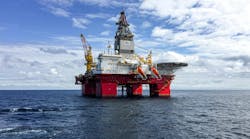Calculating PVT, ADE, and PARA
Kosta J. LeontaritisAsphWax/Kosta Oil Field Technologies- Figure 1 - Asphaltenes flocculate at low enough temperatures that the waxes begin to co-crystallize, creating tubing plugs. [11,102 bytes]
- Figure 2 - The paraffin-aromatic-resin-asphaltene (PARA) EOS oil characterization should show the asphaltenes and resins as distinct separate pseudo-components. [15,819 bytes]
- Figure 3 - To ensure better accuracy, the PARA EOS oil characterization should be tuned to some asphaltene data before it is used to calculate the ADE. {12,144 bytes]
- Figure 4 - The asphaltene deposition model should be capable of calculating hydraulics, heat transfer, phase behavior, and asphaltene deposition simultaneously. [13,143 bytes]
- Figure 5 - The formation damage model should be capable of calculating rock hydraulics, phase behavior, asphaltene deposition and formation damage simultaneously. [13,692 bytes]
The recommended approach for investigating an existing or potential organic deposition problem is prediction, diagnosis, prevention, and mitigation. An economical diagnostic preliminary suite of tests was described in a prior article to provide initial information about the organic deposition problem.
Many times, this initial suite of tests is all one needs to complete the diagnosis and provide solutions. Before any laboratory study can be started, representative oil samples must be obtained. In this paper, it is assumed that the preliminary asphaltene/wax diagnostic study found an asphaltene problem.
Phase behavior study
The asphaltene deposition envelope (ADE) of crude oils was described previously. Figure 1 is a hybrid crude oil ADE formed from a pure ADE and a wax deposition envelope. In other words, the ADE occurs (asphaltenes flocculate) at low enough temperatures that the waxes begin to crystallize as well. This type of envelope is open on two sides at both high and low temperatures.The usefulness of the thermodynamic diagram is that no asphaltene flocculation occurs at conditions outside the asphaltene deposition envelope. Hence, if the temperature and pressure profile of the produced fluid is superimposed on top of the deposition envelope (Figure 1) and the production profile crosses the asphaltene deposition envelope, asphaltene flocculation and deposition can be expected in the facilities that will operate at conditions inside the deposition envelope. The severity of the problem is the only thing not provided by the asphaltene deposition envelope diagram.
Sometimes, the asphaltene flocculation and particle formation rate inside the asphaltene deposition envelope is so small and the flow dynamics so unfavorable that asphaltene deposition is very small or negligible. In such cases, properly designed periodic pigging can be an appropriate remedy. In case of deposition in well tubings, periodic wireline scratching or cutting also may be adequate.
Obtaining the ADE
It should be recalled that the phase behavior diagram is an overlap of the vapor-liquid envelope and of the asphaltene deposition envelope. Hence, one would have to calculate both pressure-volume-temperature (PVT) and asphaltene phase behavior simultaneously to obtain the ADE. In those cases where an equation of state is used to calculate the PVT phase behavior, an equation of state oil characterization is required, as input to the equation of state.An equation of state oil characterization is a description of the fluid in terms of its components and their molecular weights, critical properties, and acentric factors. Figure 2 shows the sequence of events required for obtaining an equation of state description (EOS) of the oil. This is capable of simulating the vapor-liquid envelope of the fluid when used as input to an equation of state (Peng-Robinson EOS or Soave-Redlich-Kwong EOS).
Since the EOS oil characterization will be used to calculate the ADE of the oil, it should show the asphaltenes and resins as distinct separate pseudo-components. This is called the PARA (Paraffin-Aromatic-Resin-Asphaltene) oil characterization.
After a bottom hole sample is obtained, it should be restored to reservoir conditions, if not maintained at those conditions at all times. The preferred restoration time is usually 5-7 days at reservoir conditions.
The restored oil is used to perform a standard pressure-volume-temperature study and a PARA analysis. The PARA analysis data are then used to generate an initial PARA equation of state oil characterization. An equation of state is used to tune the initial PARA equation of state oil characterization to the pressure-volume-temperature data. A tuned equation of state (P-R EOS or S-R-K EOS), is then used to calculate the vapor-liquid envelope.
Up to this point, a PARA equation of state oil characterization has been developed that is tuned to the pressure-vapor-temperature data. To ensure better accuracy, the PARA equation of state oil characterization should be tuned to some asphaltene data before it is used to calculate the ADE. Figure 3 shows the asphaltene data required and steps necessary to tune an asphaltene model to the asphaltene phase behavior data. The main product of this is the ADE of the subject oil.
The next step is to simulate and plot the pressure and temperature profile of the produced fluid and superimpose it on the ADE. The software used to calculate the pressure and temperature profile of the produced fluid at this time does not have to have asphaltene deposition simulation capability. However, if the profile and the ADE cross each other, asphaltene deposition does occur and it very likely alters the pressure and temperature profile.
If the pressure and temperature profile and the ADE cross, an asphaltene deposition study is necessary to determine the severity of asphaltene deposition and specify remedies. More importantly, if the reservoir fluid enters the ADE while inside the formation, asphaltene-induced formation damage is to be expected and an asphaltene formation damage study is required to determine the severity of damage and specify remedies.
Asphaltene deposition study
The objective of an asphaltene deposition study is to determine the severity of asphaltene deposition in a production system, which is operating at conditions inside the ADE of the produced fluid. This requires a judicious choice of simulation and experimentation. The asphaltene deposition propensity of the produced fluid is determined in the laboratory and the data are then used to tune an asphaltene deposition simulator.The laboratory test conditions are determined by scaling down appropriately the expected field conditions. The two most important scaling criteria in such a system are the wall shear rate and the Reynolds number. The first scales down or up the hydrodynamic drag that is applied on the asphaltene particles depositing on the pipe wall. The second scales down or up the flow regime.
Unfortunately, nature does not allow us to completely simulate in the laboratory a field system because one cannot scale down or up the wall shear and Reynold's number simultaneously. Only one of the two may be set equal to the field conditions in the laboratory test. The author prefers maintaining shear rate as it appears to have the highest impact on asphaltene deposition.
Before one can simulate asphaltene deposition one must simulate accurately the oil phase behavior (Figure 2, Figure 3). An asphaltene deposition simulation provides extremely useful information:
- Asphaltene deposition severity
- Pigging frequency required
- Heating requirements
- Insulation requirements.
Formation damage study
The objective of an asphaltene formation damage study is to determine through a judicious choice of simulation and experiment the severity of asphaltene deposition in a formation, which is producing at conditions inside the ADE of the produced fluid. The asphaltene deposition propensity of the produced fluid is determined in the laboratory and the data are then used to tune an asphaltene formation damage simulator. The laboratory test conditions are determined by scaling down appropriately the expected field conditions.Figure 5 shows the steps recommended in an asphaltene formation damage study. Before one can simulate asphaltene formation damage one must simulate accurately the oil phase behavior. An asphaltene formation damage study and simulation provides useful information about:
- Asphaltene deposition severity
- Skin factor progression with time
- Need for stimulation treatments
- Frequency of stimulation treatments.
References
Leontaritis, K.J., "PARA-Based (Paraffin-Aromatic-Resin-Asphaltene) Reservoir Oil Characterization," SPE Paper No. 37252, SPE International Symposium on Oilfield Chemistry, February 18-21, 1997, Houston, Texas.Leontaritis, K.J., "Asphaltene Near-wellbore Formation Damage Modeling," SPE Paper No. 39446, SPE Formation Damage Control Conference, February 18-19, 1998, Lafayette, Louisiana.
Copyright 1998 Oil & Gas Journal. All Rights Reserved.




